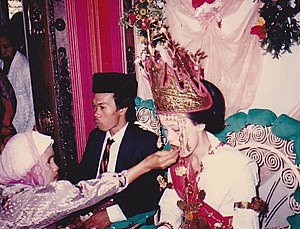Lampung people

A Lampung bride and bridegroom in 1987. Both of the couples are of the Sungkai Bungamayang clan. The traditional headgear of the bride, which is called Sikei, is commonly used in Lampung weddings.
|
|
| Total population | |
|---|---|
| (1.5 million) | |
| Regions with significant populations | |
| Lampung, Banten | |
| Languages | |
| Lampung, Indonesian | |
| Religion | |
| Islam | |
| Related ethnic groups | |
| Sundanese (Bantenese), Malays |
The Lampung people, also commonly referred to as Ulun Lampung, are an ethnic group indigenous to Lampung province and parts of South Sumatra province of the southern and central region that occupy areas such as Martapura, Muaradua at upstream of Komering River, Kayu Agung, Tanjung Raja at downstream of Komering River, Merpas on the southern side of Bengkulu province, as well as Cikoneng in the southwest coast of Banten province, Indonesia. They speak the Lampung language, a Lampungic language estimated to have 1.5 million speakers.
The origins of the Lampung people is closely tied to the name of Lampung itself. In the 7th century the Chinese had already mentioned about a place in the south (Nampang) where it is said to be the place of the Tolang Pohwang kingdom. To means "people" and Lang Pohwang means "Lampung". Hence its name Tolang Pohwang which means "Lampung people" or "envoy from Lampung" that came from China until the 7th century. There are strong evidence that Lampung was part of the Srivijaya kingdom with its capital in Jambi and did conquered parts of South East Asia region including Lampung until the 11th century.
In the 5th AD Tai-Ping-Huan-Yu-Chi chronicles, names of the Nan-hai (Southern ocean) states were recorded and among them are two states which were mentioned in sequence, To-lang and Po-hwang. The To-lang state was mentioned only once, but the Po-hwang state was mentioned many times as this state did sent envoys to China in the year of 442, 449, 451, 459, 464 and 466. According to Prof. Gabriel Ferrand (1918), it is likely that the name To-lang and Po-hwang are actually one same name and is located in Tulangbawang, Lampung.
It is said that there is also a Tulangbawang kingdom, although the idea simply came from the unification of the two names in the Chinese chronicles.
...
Wikipedia
